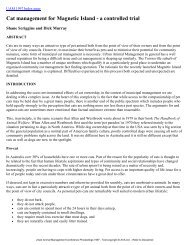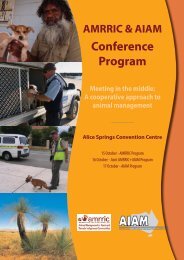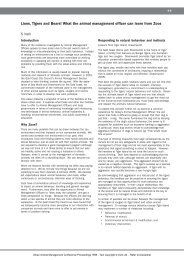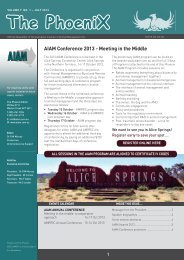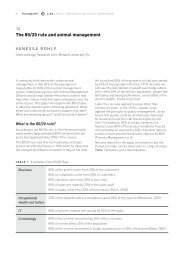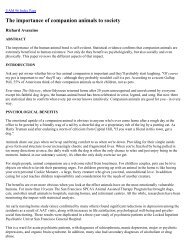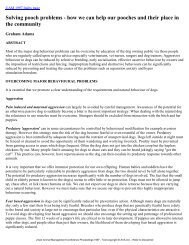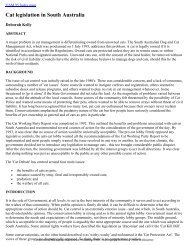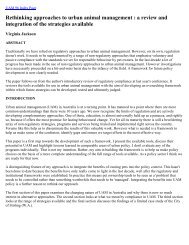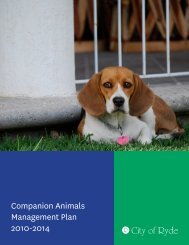Proceedings OF ThE - Australian Institute of Animal Management Inc
Proceedings OF ThE - Australian Institute of Animal Management Inc
Proceedings OF ThE - Australian Institute of Animal Management Inc
Create successful ePaper yourself
Turn your PDF publications into a flip-book with our unique Google optimized e-Paper software.
102 <strong>Proceedings</strong> 2012<br />
AIAM Annual Conference on <strong>Animal</strong> <strong>Management</strong><br />
• yAvoidance strategies such as walking away,<br />
remaining quiet and still and avoiding eye contact<br />
between dogs or between dog and human.<br />
While one or more management strategies are<br />
necessary to prevent injury or to lessen the<br />
consequences <strong>of</strong> an attack, these strategies are<br />
rarely a long-term solution. They are, however,<br />
useful for prevention <strong>of</strong> immediate attack and<br />
may be used by people who may encounter<br />
potentially aggressive dogs, including council<br />
animal management <strong>of</strong>ficers, veterinary staff, dog<br />
groomers and others. Appropriate training in dog<br />
body language and behaviour and in appropriate<br />
interactions with dogs may need to be given. <strong>Animal</strong><br />
management operating procedure may need to be<br />
revised and/or updated regularly, as knowledge on<br />
dog aggression improves.<br />
Long-term solutions<br />
for aggression<br />
To reduce canine aggressive behaviour in the long<br />
term, a range <strong>of</strong> possibilities are possible, depending<br />
on the cause <strong>of</strong> the underlying problem. Long-term<br />
solutions include:<br />
• yDesensitisation by gradually exposing the dog to<br />
the situation that provokes the fearful or angry<br />
response. Improvements have been made in<br />
dog-to-dog aggression cases after only 10 days<br />
<strong>of</strong> therapy (Orihel & Fraser, 2008) but need to be<br />
continued in the long term.<br />
• yTraining the dog to perform alternative, more<br />
acceptable, behaviours.<br />
• yActivity, routines and diets that meet the dog’s<br />
needs and ensure no threat or competition for<br />
resources (food, toys, shelter and/or attention).<br />
• yVeterinary care including diagnosis and treatment<br />
<strong>of</strong> potential medical conditions which may result<br />
in the expression <strong>of</strong> aggressive behaviour, in<br />
addition to regular check-ups.<br />
Long-term measures are vital to the reduction <strong>of</strong><br />
aggressive behaviour in any individual animal but,<br />
as these processes are not without danger, they<br />
should be overseen by an experienced behavioural<br />
pr<strong>of</strong>essional. For people that work with dogs, or<br />
encounter then on a regular basis while working, it is<br />
<strong>of</strong>ten not necessary to actually implement long-term<br />
solutions but it is imperative to inform dog owners<br />
that such options are available.<br />
Prevention <strong>of</strong> canine aggression in society<br />
In addition to reducing aggression at an individual<br />
dog level, it is essential that we reduce this unwanted<br />
behaviour at a society level. This, <strong>of</strong> necessity,<br />
involves a co-operative approach between the<br />
various stakeholders involved including:<br />
• yDog breeders - to ensure that desirable<br />
behavioural traits are bred (King et al, 2012) and<br />
that early developmental and environmental<br />
factors, which may predispose dogs to specific<br />
behavioural traits are understood and monitored<br />
(Freedman et al, 1961; Webster, 1997).<br />
• yPet owners – to ensure that suitable pets are<br />
chosen and that environmental influencers, such<br />
as socialisation and training, are understood and<br />
implemented.<br />
• yResearchers – to assess and evaluate which<br />
canine behavioural traits are desired and can be<br />
bred, developed and assessed; to monitor the<br />
incidence <strong>of</strong> canine aggression and its influencing<br />
factors in society; and to monitor the effects and<br />
effectiveness <strong>of</strong> legislation on canine aggression.<br />
• yTrainers and behaviourists – to work on a oneto-one<br />
basis with owners <strong>of</strong> aggressive dogs and<br />
those with the potential to be aggressive. This<br />
may involve temperament testing and subsequent<br />
therapies.<br />
• yGovernment bodies – to collect information<br />
about dog aggression incidents, to introduce and<br />
implement legislation and to educate pet owners<br />
on options available to reduce canine aggression.<br />
• y Public – to educate themselves and to be<br />
educated on dog behaviour and reducing the<br />
likelihood <strong>of</strong> being on the receiving end <strong>of</strong> dog<br />
aggression. This may require a coordinated<br />
approach <strong>of</strong> delivering educational programs,<br />
which are evaluated and constantly improved<br />
(based on research findings), delivered by<br />
pr<strong>of</strong>essionals and volunteers.<br />
A united and comprehensive approach to dog bite<br />
reduction is a view echoed by many organisations<br />
(eg. AVA, 2012) and involved bodies around the world.<br />
The cooperation <strong>of</strong> all stakeholders in the humananimal<br />
relationship will ensure that the humancanine<br />
bond remains positive in the future.<br />
References<br />
A.V.A. (2012). Dangerous dogs – a sensible solution. Policy<br />
and model legislative framework. The <strong>Australian</strong> Veterinary<br />
Association Ltd. www.ava.com.au.<br />
Beaver, B. (2001). A community approach to dog bite prevention<br />
– AVMA Task Force on Canine Aggression and Human–Canine<br />
interactions. J Am Vet Med Assoc, 281: 1732–1749.<br />
Freedman, D.G., King, J.A and Elliot, O. (1961). Critical period in<br />
the social development <strong>of</strong> dogs. Science, 133: 1016-1017.<br />
Gershman, K.A., Sacks, J.J. and Wright, J.C. (1994). Which dogs<br />
bite? A case-control study <strong>of</strong> risk factors. Pediatrics, 93: 913-917.<br />
Herron, M., Sh<strong>of</strong>er, F.S. and Reisner, I.R. (2009). Surey <strong>of</strong> the use<br />
and outcome <strong>of</strong> confrontational and non-confrontational training<br />
methods in client-owned dogs showing undesired behaviours.<br />
App Anim Behav Sci, 117: 47-54.<br />
Hsu, Y. and Sun, L. (2010). Factors associated with aggressive<br />
responses in pet dogs. App Anim Behav Sci, 123: 108-123.



